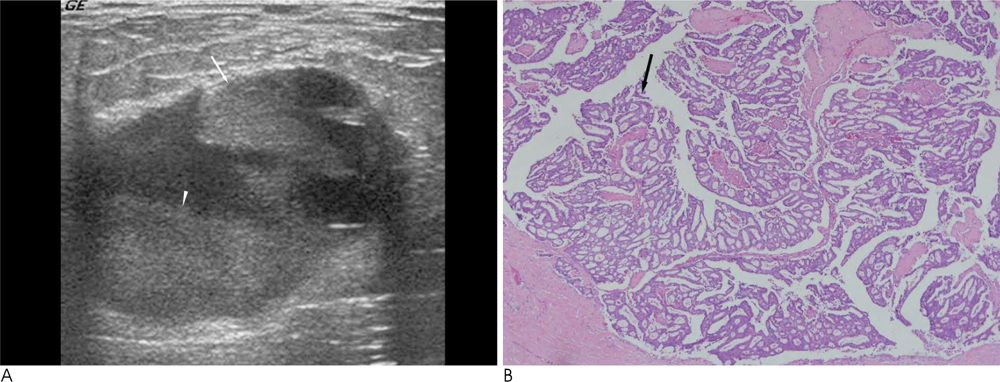J Korean Soc Radiol.
2011 Mar;64(3):273-279. 10.3348/jksr.2011.64.3.273.
Review of Breast Cancers That Can Mimic a Cystic Component: Ultrasonographic and Pathologic Correlations
- Affiliations
-
- 1Department of Radiology, Soonchunhyang University Hospital, Korea. ywchang@hosp.sch.ac.kr
- 2Department of Radiology, Soonchunhyang Cheonan Hospital, Korea.
- 3Department of Radiology, Soonchunhyang Gumi Hospital, Korea.
- 4Department of Pathology, Soonchunhyang University Hospital, Korea.
- KMID: 2097950
- DOI: http://doi.org/10.3348/jksr.2011.64.3.273
Abstract
- We illustrate the sonographic findings of malignant breast masses that can mimic a cystic component with pathologic correlations. The disease entities presented in this study include infiltrating ductal carcinoma, ductal carcinoma in situ (DCIS), papillary carcinoma, mucinous carcinoma, medullary carcinoma, metaplastic carcinoma, and a malignant phyllodes tumor. Malignant masses with a cystic component are often characterized by well-circumscribed round, oval, or lobular masses, thereby appearing benign on ultrasonography. On pathology, the cystic component of a malignant mass is identified by cystic degeneration, hemorrhage, necrosis, or ductal dilatation. If the mass is well-circumscribed with a cystic component, a biopsy should be considered in the analysis of the solid component within a mass.
MeSH Terms
Figure
Reference
-
1. Venta LA, Dudiak CM, Salmon CG. Sonographic evaluation of the breast. Radiographics. 1994; 14:29–50.2. Berg WA, Campassi CI, Ioffe OB. Cystic lesions of the breast: sonographic-pathologic correlation. Radiology. 2003; 227:183–191.3. Omori LM, Hisa N, Ohkuma K. Breast masses with mixed cysticsolid sonographic appearance. J Clin Ultrasound. 1993; 21:489–495.4. Harvey JA. Unusual breast cancers: useful clues to expanding the differential diagnosis. Radiology. 2007; 242:683–694.5. Moon WK, Myung JS, Lee YJ, Park IA, Noh DY, Im JG. US of ductal carcinoma in situ. Radiographics. 2002; 22:269–280.6. Wagner AE, Middleton LP, Whitman GJ. Intracystic papillary carcinoma of the breast with invasion. AJR Am J Roentgenol. 2004; 183:1516.7. Lam WW, Chu WC, Tse GM, Ma TK. Sonographic appearance of mucinous carcinoma of the breast. AJR Am J Roentgenol. 2004; 182:1069–1074.8. Liberman L, LaTrenta LR, Samli B, Morris EA, Abramson AF, Dershaw DD. Overdiagnosis of medullary carcinoma: a mammographic-pathologic correlative study. Radiology. 1996; 201:443–446.9. Gunhan-Belgen I, Memis A, Ustun EE, Zeikioglu O, Ozdermir N. Metaplastic carcinoma ot the breast: clinical, mammographic, and sonographic findings with histopathologic correlation. AJR Am J Roentgenol. 2002; 178:1421–1425.10. Liberman L, Bonaccio E, Hamele-Bena D, Abranson AF, Cohn MA, Dershaw DD. Benign and malignant phyllodes tumors: mammographic and sonographic findings. Radiology. 1996; 198:121–124.
- Full Text Links
- Actions
-
Cited
- CITED
-
- Close
- Share
- Similar articles
-
- Small Breast Cancer (≤ 5 mm): Ultrasonographic Features and Clinical and Pathological Characteristics
- Differentiation of Benign and Malignant Cystic Lesions of the Breast according to Sonographic Findings
- Ultrasonographic Findings of Metaplastic Squamous Breast Carcinoma and the Pathologic Correlation
- Pathologic Evaluation of Breast Cancer after Neoadjuvant Therapy
- Radiologic findings of male breast cancer: two cases report








